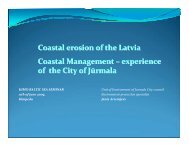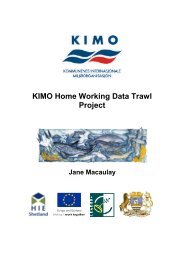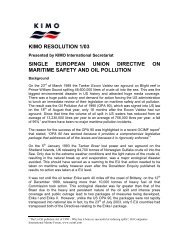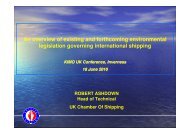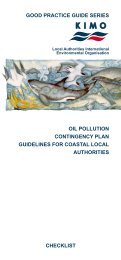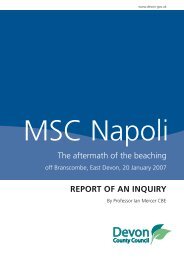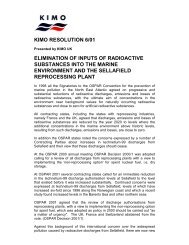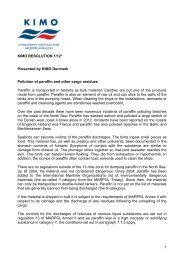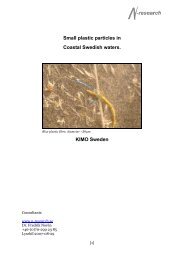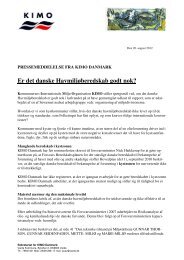Download the full microplastics research proposal here. - KIMO
Download the full microplastics research proposal here. - KIMO
Download the full microplastics research proposal here. - KIMO
You also want an ePaper? Increase the reach of your titles
YUMPU automatically turns print PDFs into web optimized ePapers that Google loves.
Fig. 3) Microscopic fragment of plastic in gut<br />
of a Sand hopper (Orchestia gammarellus).<br />
Research Project Proposal<br />
Do microplastic fragments present a hazard to marine life?<br />
Richard C Thompson and Steve J Rowland, University of Plymouth UK<br />
A call for project / funding partners in conjunction with <strong>KIMO</strong> International<br />
Plastics have brought many societal benefits and are hugely important in modern life. As a<br />
consequence annual production has increased from 5 million tonnes in <strong>the</strong> 1950s to over 230<br />
million tonnes today. Because of <strong>the</strong>ir durability, discarded plastic items are accumulating in<br />
landfill and as litter in terrestrial and aquatic habitats. This debris poses a global environmental<br />
problem and has been identified as one of <strong>the</strong> most important pollution-related issues in <strong>the</strong> UK.<br />
Since most plastics are buoyant <strong>the</strong> problems<br />
associated with this debris are particularly evident in<br />
marine habitats w<strong>here</strong> over 180 species including<br />
mammals, birds, fish and invertebrates are known to<br />
ingest plastic. The incidence of ingestion can be<br />
extremely high. For example, in <strong>the</strong> North Sea over<br />
95% of Fulmars (Fulmarus glacialis) were found to<br />
have plastic in <strong>the</strong>ir guts (Fig. 1). T<strong>here</strong> is increasing<br />
concern that ingestion of plastic debris presents a<br />
hazard to wildlife and could lead to <strong>the</strong> transfer toxic Fig. 1) Plastic from <strong>the</strong> stomach of a Fulmar<br />
chemicals to <strong>the</strong> food chain.<br />
Our <strong>research</strong>, at <strong>the</strong> University of Plymouth, has shown that plastic debris is fragmenting in <strong>the</strong><br />
environment and that microscopic pieces of common polymers (<strong>microplastics</strong>, Fig. 2 A)<br />
including polyethylene, polyvinyl chloride and polypropylene are now present on shorelines and<br />
in <strong>the</strong> water column throughout <strong>the</strong> North East Atlantic. Pieces as small as 2µm have been<br />
identified and <strong>the</strong>ir abundance has increased over <strong>the</strong> last 40 years (Fig. 2A - E). Some<br />
samples of strandline material now contain more that 10% plastic and because conventional<br />
polymers will not biodegrade it seems inevitable that <strong>the</strong> abundance of <strong>the</strong>se fragments will<br />
continue to increase. Their abundance toge<strong>the</strong>r with <strong>the</strong>ir size mean that such fragments could<br />
be ingested by a wide range of organisms including birds, fish and small invertebrates (Fig. 3).<br />
Fragments of plastic have been shown to concentrate<br />
pollutants that have arisen in <strong>the</strong> environment from<br />
o<strong>the</strong>r sources. This effect can be substantial with<br />
persistent organic pollutants such as PCBs, DDE,<br />
nonylphenols and phenanthrene becoming 5 to 6<br />
orders of magnitude more concentrated on plastic<br />
debris than in <strong>the</strong> surrounding seawater. Some<br />
plastics also contain potentially harmful substances<br />
that are incorporated during manufacture as flameretardants,<br />
plasticisers and antimicrobials. Research<br />
in our laboratories, using <strong>the</strong> lugworm, Arenicola<br />
Marina (a common deposit feeder eaten by numerous<br />
species of birds and fish), has shown that ingestion of plastic could provide a mechanism<br />
facilitating <strong>the</strong> transport of <strong>the</strong>se pollutants to <strong>the</strong> food chain.<br />
Given <strong>the</strong> quantities of plastic waste that are discarded annually it is now essential to establish<br />
<strong>the</strong> <strong>full</strong> environmental significance of plastic debris in <strong>the</strong> transport of pollutants to marine life.<br />
We have developed a <strong>research</strong> programme to address this using a range of differing polymer<br />
types (including plastics of differing size and age) and contaminants. Uptake of contaminants<br />
toge<strong>the</strong>r with any associated biological consequences will be evaluated using deposit and filter<br />
feeding marine organisms. Experiments will be run alongside appropriate controls, using natural<br />
particulates, to establish <strong>the</strong> extent to which ingestion of plastic fragments results in an
additional burden of contaminants in animal tissues. The outcomes of <strong>the</strong>se experiments will<br />
<strong>the</strong>n be modelled to give a risk assessment of <strong>the</strong> types, quantities and condition of plastic<br />
debris that would be required to cause detrimental effects on natural populations.<br />
A<br />
B<br />
C<br />
Transmission (%)<br />
50 µm<br />
fragment from shore<br />
nylon<br />
4000 2400 1400 650<br />
Wave number cm -1<br />
D<br />
Fibers 50ml -1 sediment<br />
8<br />
6<br />
4<br />
2<br />
0<br />
Sandy<br />
*<br />
Estuarine<br />
Subtidal<br />
E<br />
Fibers m 3 seawater<br />
0.08<br />
0.06<br />
0.04<br />
0.02<br />
0<br />
CPR 2<br />
*<br />
1960's<br />
1970's<br />
1980's<br />
1990's<br />
25<br />
20<br />
15<br />
10<br />
5<br />
0<br />
CPR 1<br />
Production of syn<strong>the</strong>tic<br />
fibers 10 3 tons yr -1<br />
Fig. 2) (A) Fragment of microscopic plastic<br />
from shoreline. (B) Sampling locations in<br />
North-East Atlantic, showing Routes<br />
sampled by Continuous Plankton Recorder<br />
(CPR 1 and 2) since 1960 and used to<br />
assess <strong>the</strong> abundance of <strong>microplastics</strong> in <strong>the</strong><br />
water column (Fig. 1E). Shores w<strong>here</strong><br />
similar fragments were found (●) and<br />
location of sites near Plymouth (□) used to<br />
compare <strong>the</strong> abundance of microscopic<br />
plastic among habitats (Fig. 1D). (C)<br />
Example showing how FT-IR spectroscopy<br />
was used to identify fragments from <strong>the</strong><br />
environment. Here an unknown fragment is<br />
identified as nylon. (D) T<strong>here</strong> were<br />
significant differences in abundance of<br />
<strong>microplastics</strong> between sandy beaches and<br />
subtidal habitats (ANOVA, F 2,3 = 13.26, * =<br />
P < 0.05), but abundance was consistent<br />
among sites within habitat type. (E)<br />
Accumulation of microscopic plastic in CPR<br />
samples revealed a significant increase over<br />
time when comparing <strong>the</strong> 1960’s and 1970’s<br />
to <strong>the</strong> 1980’s and 1990’s (ANOVA F 3,3 =<br />
14.42, * = P < 0.05). Approximate figures for<br />
global production of syn<strong>the</strong>tic fibres overlain<br />
for comparison. Microplastics were also less<br />
abundant along <strong>the</strong> oceanic route CPR 2<br />
than CPR 1 (F 1, 24 = 5.18, P < 0.5).<br />
Reproduced with permission from Thompson<br />
et al. (2004), Lost at sea w<strong>here</strong> does all <strong>the</strong><br />
plastic go? Science, 304, 838.<br />
The proposed <strong>research</strong> will require a three-year position for an experienced postdoctoral<br />
<strong>research</strong>er toge<strong>the</strong>r with technical support for <strong>the</strong> numerous analyses and invertebrate trials.<br />
The University of Plymouth has all of <strong>the</strong> facilities to undertake <strong>the</strong> work, including a state of <strong>the</strong><br />
art ISO 900-acredited radio-chemical facility. Costs for <strong>research</strong> staff, consumables and<br />
overheads are around £150,000 per year for three years (total £450,000). We are applying to<br />
<strong>the</strong> Natural Environment Research Council (NERC) for funding in <strong>the</strong> form of a partnership<br />
grant (deadline 1/12/08). These grants require a 25% external contribution with NERC covering<br />
<strong>the</strong> remaining 75% of <strong>the</strong> costs. We are <strong>the</strong>refore seeking partners to contribute some or all of<br />
<strong>the</strong> £112,500 external funding (£37,500 per year for three years).<br />
Our work to date has attracted considerable interest from <strong>the</strong> general public, <strong>the</strong> media (New<br />
York Times, Washington Post, La Monde, El Pais, Guardian, BBC), government (Defra and<br />
Cefas in <strong>the</strong> UK and NOAA in <strong>the</strong> US) and non-government organisations including OSPAR,<br />
<strong>KIMO</strong> and Marine Conservation Society. The proposed work represents a major advancement<br />
in our knowledge about <strong>the</strong> effects of debris in <strong>the</strong> environment. <strong>KIMO</strong>, an international<br />
association of local authorities committed to reducing marine litter, have given <strong>full</strong> support to <strong>the</strong><br />
<strong>proposal</strong> and agreed to facilitate discussions with potential project partners/funders. <strong>KIMO</strong> will<br />
subsequently act as an advisor on <strong>the</strong> steering committee and promote <strong>the</strong> project results to<br />
policy makers through <strong>the</strong>ir observer status at <strong>the</strong> OSPAR Commission. It may also be possible<br />
for o<strong>the</strong>r funders to join <strong>the</strong> steering committee. Fur<strong>the</strong>r information on how to participate with<br />
<strong>KIMO</strong> as a project partner/funder can be obtained from John Mouat<br />
(john.mouat@kimo.shetland.org) or Dr Richard Thompson (rcthompson@plymouth.ac.uk).



